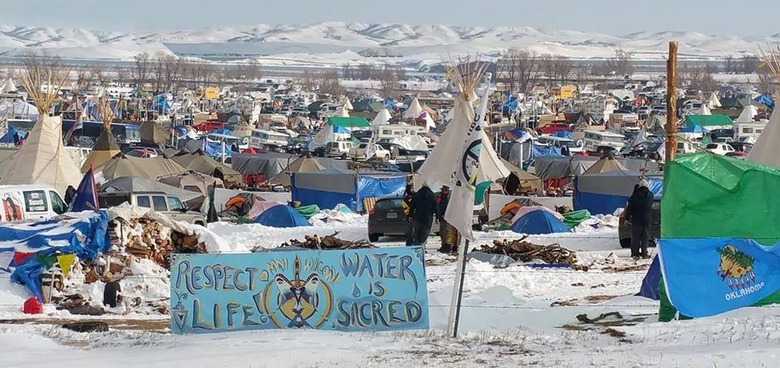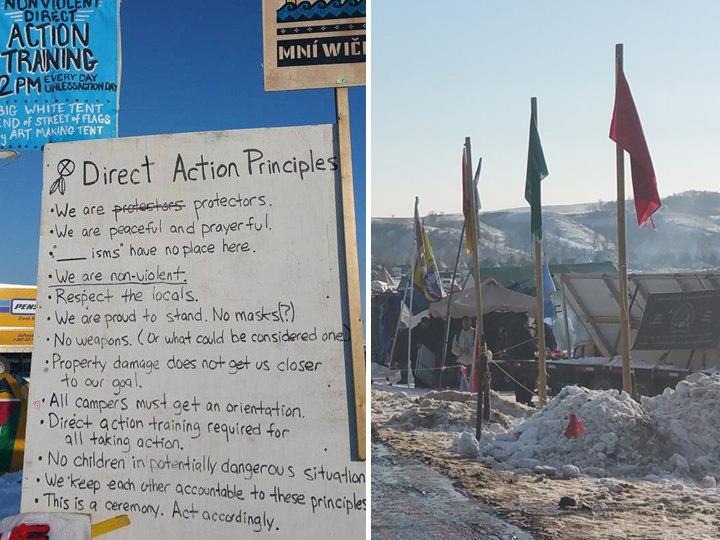Why The Dakota Access Pipeline Fight Isn't Over (And Standing Rock Knows It)
This week the US Army CoE said they'd stopped the DAPL oil pipeline the same day authorities' Protester Evacuation Deadline was up – quite a coincidence. It should therefore come as no surprise that the thousands of water protectors (or protestors, if you prefer) have not left their camp after a brief celebration in halting construction. If this pipeline does, indeed, remain stopped and incomplete, it'll strike a major blow for both native rights and a future for electric vehicles taking the place of fossil fuel-hungry automobiles.
The sequence of events that's lead to this 4th of December is epic – and more than a little bit confusing for those that haven't been following along. The "local authorities" evacuation order for the 4th can be seen at Stand with Standing Rock where a PDF is linked alongside word from the local Standing Rock Sioux tribe. This order was mandated by the same US Army Corps of Engineers that suggested that they'd denied an easement for Dakota Access to drill under Lake Oahe. This order worked in concert with an executive order from Governor Jack Darlymple (see PDF) which told protestors to leave the land in anticipation of "severe winter weather storm conditions."
The easement was the final legal block that stood in the way of the $3.7-billion-dollar oil pipeline that's been under construction for months. This pipeline has been protested by an ever-growing group of Native American tribes from across the United States. Non-native allies, including a hundreds-strong group of United States war veterans that just arrived this past weekend, have also joined in on this protection effort.

Citizens in the protest call themselves Water Protectors instead of protesters because of their position in this clash. Would that the pipeline be tunneled under the Missouri River – in this location especially – drinking water for thousands would be put at risk. In this location specifically, the Standing Rock Sioux tribe would be put at risk in a big way.
According to a release from the North Dakota Department of Health, an oil pipeline spill was discovered on Monday, the 5th of December, 2016. That's just this week. This spill was found approximately 16 miles northwest of Belfield, ND, and broke from a 6-inch diameter pipeline operated by Belle Fourche Pipeline. This spill has leaked an unknown volume of oil into the Ash Coulee Creek.
Our own research into the document linked through USACE (below) shows that Dakota Access does have a plan for a pipeline break under the Missouri River. Their plan is to provide water bottles to all those people affected. Water bottles and that's it.
The photo at the head of this article comes VIA Standing Rock Rising. Other photos above and below come from photographer and water protector Victory Lonnquist. For more photos from this collection, see her Facebook collection. All photos were posted on December 4th and were captured over the weekend.

An alternative route was included in the Dakota Access, LLC Environmental Assessment (available for perusal at the USACE Digital Library) (USACE: U.S. Army Corps of Engineers.) This alternative "North Bismarck" route was abandoned due to it crossing "through or in close proximity to several wellhead source water protection areas that are identified and avoided in order to protect areas that contribute water to municipal water supply wells."
This pipeline would transfer "at least 570,000 barrels of crude oil per day (bpd)" under the Missouri river at Lake Oahe (reservoir), endangering the water supply of the Standing Rock Sioux Reservation as well as any community with intake structures downstream.
Construction of the pipeline has been underway for many months. The United States Army Corps of Engineers had not – until this week – made a final ruling on a crucial easement of land under Lake Oahe. The vast majority of the pipeline was built before Dakota Access had all necessary permits in place.
It is because of this, and because of the treatment of the protesters (AKA water protectors) throughout this series of events, that this opposition remains in North Dakota. Native people have celebrated, but I would not be surprised if this protest did not end any time soon. As the construction of this pipeline and the major protests that oppose it continue, we'll be keeping a weather eye.
